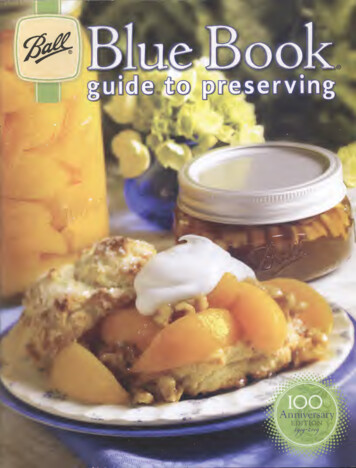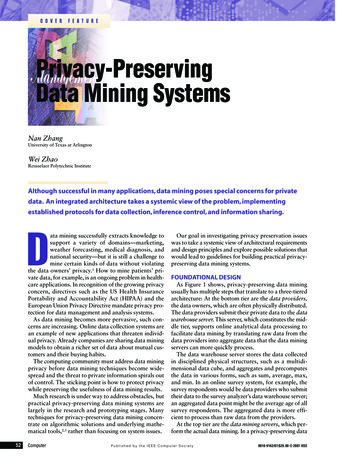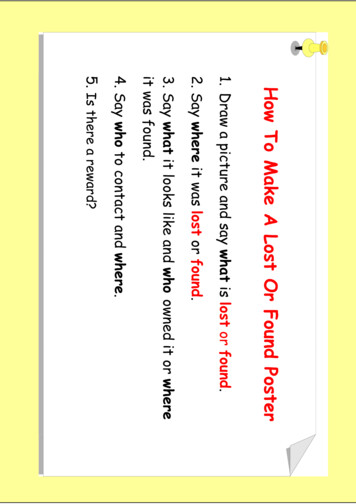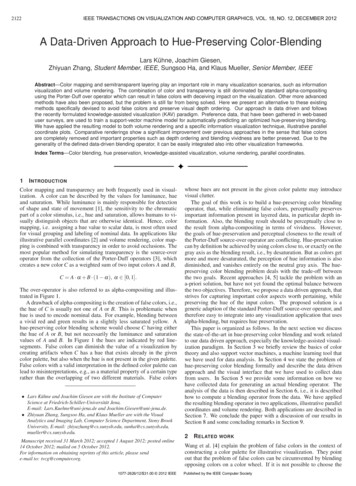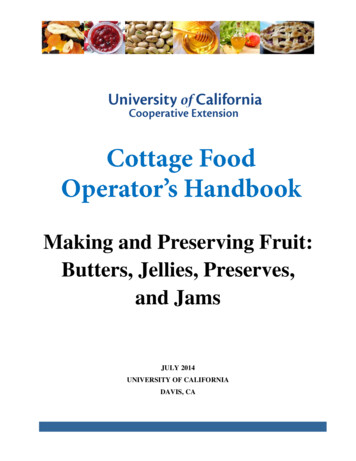
Transcription
The Lost Book of Preserving Food NaturallyTable of ContentsIntroduction . 4The Roots of Food Preservation . 7The Enemies of Our Food . 8Why Preserve Your Own Food? . 8Salt & Sugar – Nature’s Preservatives . 10Chapter 1: Drying Food to Preserve It . 13Dehydrating vs. Freeze Drying . 15Drying Fruits & Vegetables . 16Dried Meat or Jerky . 18Salt Fish . 19Chapter 2: Preserving by Canning . 22The Canning Process. 25Pressure Canning . 27Dry Canning . 27Pickling . 28Chapter 3: Packaging Dry Foods for Long-Term Storage . 30Smoking & Curing Meats. 34Smoking the Meat . 36Curing Meats . 37Chapter 4: Cold as a Preservative . 39Refrigeration without Electricity . 41Root Cellars. 432
The Lost Book of Preserving Food NaturallyThe Ice House . 44In Conclusion . 463
The Lost Book of Preserving Food NaturallyIntroductionWe all need food; that’s a basic fact of life. While you may be able to survive without foodfor a while, you’ll eventually use up your body’s energy reserves and need to eat more.This has caused a large portion of human activity throughout history to be dedicated tomeeting that basic need. Growing food has become one of the world’s major industries.More than that, it’s not only growing food that has become important, but processing,preserving, distributing and selling that food as well.All food comes from nature, in one way or another. Even in our modern world of GMOs(genetically modified organisms) and cross-breeding of species, food is still a naturalsubstance. Everything we eat comes from plant life or animal life, even those thingswhich have chemicals thrown in.But the same natural processes which cause food to grow also cause it to spoil. Wehumans are not the only things that want to eat the food that we produce. Insects, rodentsand bacteria need that food to survive as well; and when they get into our food, they tendto render it unsuitable for human consumption.This has led to the need for developing various means for preserving the foods that weeat. Any method we use for preserving food is intended to keep those insects, rodentsand bacteria from eating the food, but more than anything, they are intended to keepbacteria from eating it. Most “spoilage” and decomposition of food is accomplished bybacteria eating that food.As far back in recorded history as you look, you’ll find mention of food being preservedin a variety of means. Ancient tombs around the world have been opened, to find driedgrains and other food preserved along with the bodies of kings and priests. This food hadbeen left for them to eat on their journey through the afterlife. Interestingly enough, in4
The Lost Book of Preserving Food Naturallymany cases, the food has survived the centuries, in better shape than the bodies it wasburied with.Today, food preservation has changed dramatically. While we still use the old methodsof food preservation, most of the foods you can buy in the supermarket are preservedwith chemicals. These chemicals kill the bacteria which would otherwise eat the food,supposedly rendering the food safe for use. But those chemicals aren’t much better forhuman bodies, than they are for bacteria. The only reason we don’t see them causingmore damage, is that our bodies are much bigger than those of bacteria. So the impact ofthose chemicals is much less.Yet there is a trend in society to move away from artificial preservatives and move moretowards natural means of preserving food. More and more people are becomingdistrustful of those chemicals, preferring to consume foods with ingredients that theycan pronounce. While the junk food industry is in no danger of losing all their sales, theircustomer base is slowly dwindling.Part of this is due to the mistrust of GMOs, which have never been fully tested. We findthat people on both ends of the political spectrum distrust those foods and are unhappywith the idea of being used as lab rats in an experiment to find out if they are safe.At the same time, more and more people are seeking to preserve food at home, either dueto a return to growing their own foods for health reasons or as a part of preparing for adisaster. Should a TEOTWAWKI (the end of the world as we know it) event strike thecountry, such as a loss of the electrical grid, the ability to preserve food may be anessential skill for surviving in a post-disaster world.Yet few people today have the knowledge to preserve food in the home. This knowledge,which was commonplace in the time of our grandparents, has become a rarity today. We5
The Lost Book of Preserving Food Naturallyhave become so accustomed to consuming what others produce, that overall, we haveforgotten how to be producers ourselves.This book is about returning to those old ways. We will discuss the various means whichyou can use to preserve food in your own home. Armed with this information, you couldcreate a fully-stocked pantry, ready for any disaster, even if that’s just making it throughthe winter.6
The Lost Book of Preserving Food NaturallyThe Roots of Food PreservationSince the foods we eat grow naturally, we have to accept that they have a natural growingcycle. This means that there will always be seedtime and harvest, regardless of where welive or what sort of food we want to eat. Even animals have a seedtime and harvest,although that is usually totally outside of our control.In hot climates, you can harvest food from nature year round. Southern Mexico, forexample, is a very fruitful area, with most people having a variety of fruit trees on theirproperty. Some of those, like bananas, give fruit year-round, while others only give fruitin their season. But between the two of those, you can find something to eat, pretty muchany time of the year.But things are much different in the colder climates of Europe and the Northern UnitedStates. There, you may only have a short growing season of three to four months. Duringthat time, you must plant, harvest, hunt, gather and preserve enough food to get youthrough the cold winter months. If you don’t, chances are that you will starve to deathbefore spring comes around again.This makes food preservation critical in the colder climates, explaining why many of ournatural food preservation techniques originate there. But we cannot ignore that thepeople of Egypt and the Mayans of Mesoamerica, both of which were in hot climates,dried grains for use and storage.While the Mayans may not have needed to preserve food to get through the cold winter,they did have to deal with the hurricane season. Hurricanes, with their high winds, willstrip trees of their fruit and flatten crops that have not been harvested. Likewise, the NileRiver, which the Egyptians counted on to water their crops, had a dry season when theycouldn’t grow food. So even in these supposedly ideal growing climates, there was a needto preserve food.7
The Lost Book of Preserving Food NaturallyThe Enemies of Our FoodAs anyone who has pets knows, we are not the only ones who consume the things weconsider food. Animals of all kinds want to eat the same things that we do, regardless oftheir size. Gardeners fight this all the time, with birds, insects and even possums gettinginto their gardens to eat their fresh growing produce. However, most food spoilage is notdue to pets or even rodents, rather it is due to bacteria and insects.But bacteria, insects and rodents aren’t the only enemies of any food that we try to store.Heat, light and oxygen can damage it too. Enough heat can cause food to cook while it isstored. Oxygen causes certain foods to oxidize, especially when it is combined with heat.That oxidation can change the nutritional value of the food, but it usually just changes itsappearance.The whole idea of preserving food is to keep these enemies of our food from damagingthe food we are storing away for a rainy (or cold) day. Many methods have beendeveloped over the centuries, which allow the storage of just about any type of food forprolonged periods of time, just as long as the food is properly prepared or “preserved”for storage. Except for fresh fruit, vegetables, meats and dairy, just about everything youfind in your local grocery store has been preserved in one way or another.Why Preserve Your Own Food?There are many reasons why you might want to preserve your own food. Theaforementioned problem of GMOs is merely one. But there are much better reasons forpreserving food at home; such as freshness. Most of the foods we buy at the grocery storeare harvested early, to help prevent the possibility of them going bad before they arepreserved. Between that, transportation and the queuing of the food at the factory, youaren’t getting the freshest possible food.On the other hand, if you preserve your own food, you can literally go from the garden tothe can. You can smoke meats as soon as the animal is slaughtered. You can ensure that8
The Lost Book of Preserving Food Naturallythe food you are preserving is at its peak ripeness and preserved before it can begin todeteriorate.Not only that, but you can choose the specific varieties of food that you preserve.Commercial farms grow varieties of produce that provide them with the maximum yield,all ripening at the same time. While that may be necessary for a commercial farm to beproductive and profitable, it is not the best for ensuring flavor and nutrition. Othervarieties, usually the heirloom varieties of those fruits and vegetables, generally havebetter flavor and nutrition.It’s clear that preserving your own food will help ensure that you are feeding your familythe best possible meals. The flavor, freshness and nutrition you can pack into your ownpreserved foods will always be better than what you can get in commercial foods. Butthere’s a still more important reason to preserve your own food; that’s survival.None of us know what tomorrow may hold. Out technology driven society dependsheavily on electronics and the electricity that drives those electronics. This is our greatestvulnerability. If an enemy were to take out our electrical grid, either through the use of ahigh-altitude EMP (electromagnetic pulse), cyber-warfare of active terrorist attacks, itwould bring our country to its knees.All three of these are very real possibilities. We have enemies today who are workinghard at developing the ability to do them. North Korea has announced their intention toattack us with an EMP; China and Russia are constantly “tickling” the control systems toour electrical grid, and have already shown they can gain access to our power plants. Notonly that, a power substation in San Juan, California was taken out by a man with a rifle,which is believed to have been a test to see if it could be done by terrorists.Should any of these attacks materialize, our country would come to a screechingstandstill. According to the report of the EMP Commission, an EMP or similar loss of the9
The Lost Book of Preserving Food Naturallygrid would result in the deaths of as much as 90% of our population within the first year.Most of those people would die of starvation. Without the ability to feed yourself andyour family, you could become one of those fatalities.So learning how to preserve food is an important survival skill. As long as you aredependent on the food distribution network to feed you, you are at risk. Being able togrow your own food and then preserve what you grow, could very well make thedifference between life and death for your family.Salt & Sugar – Nature’s PreservativesModern food-processing plants use a wide variety of chemical preservatives to killbacteria and prevent food going bad. But there is no need for all those chemicals, whosenames we can’t pronounce. Nature herself has provided us with preservatives which wecan use to keep food from spoiling; salt and sugar.Both salt and sugar work by essentially the same method, although they are not normallyused for the same foods. Sugar is usually only used as a preservative for fruit, while saltis used for pretty much everything else. So you are much more likely to encounter saltbeing used as a preservative, than sugar.All life needs some salt, especially animal life. But the amount of salt needed to preservelife is minimal. You and I have salt in our bodies. The amount of salt is critical, as too littlesalt makes it difficult for our bodies to hold in enough water and too much salt makes itso that we retain excessive water. An excess of salt can also cause a variety of healthproblems.But we aren’t concerned about how much salt is in the body; we’re concerned about usingsalt for a preservative. In that regard, we need to understand osmosis.Osmosis is the scientific term for a natural process in which water (or another solvent)passes through a semi-permeable membrane, to equalize the concentration of the10
The Lost Book of Preserving Food Naturallysolution on both sides of that membrane. So, water will move from a low-concentrationarea, across the semi-permeable membrane, to a high-concentration area, until theconcentration is the same on both sides.For the purpose of food preservation, the concentration we are referring to come fromeither salt or sugar. If there is more salt on one side of a membrane, than there is on theother side, water will move through the membrane to equalize the levels. Since cell wallsare semi-permeable membranes, this works with all vegetables, fruit and meats. It alsoworks with bacteria.You can see the results of this by doing a simple experiment. Take a piece of raw meatand put it on a plate, drying the surface with a paper towel. Then sprinkle a liberal coatingof salt onto the meat, allowing it to sit. Within a few minutes, the salt will be wet, havingdrawn water out of the meat.Bacteria are single-cell organisms. As such, they are also surrounded by semi-permeablemembranes. The space between the various parts of the cells, just like the cells in ourbodies, is filled with water. So, when salt comes into contact with bacteria, it draws waterout of the bacteria, just like it draws it out of meat or any other food. When it drawsenough water out of the bacteria, the bacteria dies.While the main idea behind osmosis is that the water passes across the membrane, saltwill pass across the membrane in the opposite direction, increasing the salt level in thecells of the food. This is an important part of the preservation process, as that protectsthe food from further infestations of bacteria. As long as the level of salt in the food ishigh enough to draw water out of any bacteria that comes into contact with the food, itwill kill the bacteria.This is why so many preserved foods are salty. While modern food processing plants usechemical preservatives, they also use salt. It is the salt, more than the chemicals, which11
The Lost Book of Preserving Food Naturallyprotect the food from bacterial. The chemicals mostly preserve the appearance of thefood.12
The Lost Book of Preserving Food NaturallyChapter 1:Drying Food to PreserveIt13
The Lost Book of Preserving Food NaturallyDrying food is probably the oldest known means of preserving it, going back millennia.Most grains are dried before use, often on the stalk. This probably gave our earlyancestors the idea of drying other grains, such as corn, which are not dried on the stalk.Dried grains could be stored and often were, to provide a food source during drought.One of the earliest recorded cases of this is found in the Bible. During the 19 th CenturyBC, Pharaoh had a pair of dreams, which warned of coming drought. These dreams wereinterpreted by a Hebrew slave, Joseph, who was a prisoner at the time. This causedPharaoh to promote Joseph, making him Prime Minister of Egypt so that he could preparethe nation for the coming drought. Joseph accomplished this by placing a levy on the grainthat was grown and storing up that grain to get them through the coming hard times.Grains are still dried today, although unless you are planning on growing grain in yourbackyard, you are unlikely to end up drying your own. This is handled at the commerciallevel, where most of those grains are also ground into flour.However, many other foods are dried today, both commercially and at home. Most foodscan be dried, including meats, vegetables and fruits. The process of drying the foodsprovides a natural defense against bacteria. If the foods are then properly stored toprotect them from insects and rodents, they will keep for an extended time.How does drying food preserve it? Bacteria need a moist environment to survive. As wediscussed when I was talking about salt, the loss of enough water will cause bacteria todie. Just as osmosis will cause water to cross a membrane to equalize chemical or minerallevels across the membrane, it will also cross a membrane when the moisture levels aredifferent. This makes dried food is a very inhospitable environment for bacteria to livein.14
The Lost Book of Preserving Food NaturallyDehydrating vs. Freeze DryingMost dried foods throughout history have been dehydrated. This is a process wheresunlight or heat are used to draw the moisture out of the food. Of the two, sunlight hashistorically been more common, although modern dehydration techniques use heat.Freeze drying is a newer process, which has been developed for use with foods that don’tdehydrate well. Some fruits, like berries, don’t turn out well when dehydrated, but areshriveled and hard. While they can be rehydrated, they really can’t be eaten as they are.Freeze drying provides an option in those cases, providing dried foods that appear moreappetizing (because they look more like the moist version) and are edible withoutrehydration.Freeze drying can also be used for some foods that one would not expect to be able to bedried, like ice cream. The invention of freeze drying coffee revolutionized the coffeeindustry, providing a means of making instant coffee that tasted almost as good as freshbrewed.While it is possible to freeze dry foods at home, the equipment is considerably moreexpensive than dehydrating. The three-step process for freeze drying is also morecomplicated. It consists of freezing the food, then placing it in a vacuum chamber. Lowheat is applied, along with the vacuum. This causes the water crystals to evaporatedirectly in a process known as sublimation. After this, the food undergoes secondarydrying, in which remaining water is removed under higher temperature.In a survival situation, freeze drying probably wouldn’t be effective, because it requiresmuch more electricity than dehydrating does. Since dehydrating food can beaccomplished with nothing more than solar power, it would be much more effective in asurvival situation.15
The Lost Book of Preserving Food NaturallyDrying Fruits & VegetablesHome dehydration can be accomplished with a commercially manufactured dehydrator,of which there are many models on the market. While it is theoretically possible todehydrate in a normal kitchen oven, the temperature control doesn’t go low enough forproper dehydration. So in order to use it, you need to be manually controlling thetemperature by turning the oven on and off or by opening and closing the oven door.Typically, the lower cost dehydrators have a heating element in the bottom, with a seriesof trays that can be stacked one above the other. This provides uneven drying times, asthe trays which are closer to the heating element receive more heat. Most people whouse these end up juggling the trays, restacking them throughout the process to try andmake everything dry evenly.Better dehydrators use a side-mounted heating element with a fan. This forces the heatthroughout the cabinet, much like a convection oven. In doing this, the heat is much moreevenly distributed, ensuring that the food dries at a more even rate. These dehydratorsare also larger, allowing you to dehydrate more food at one time.It is also possible to dehydrate using the power of the sun. Commercially available solardehydrators consist of a net cage, with shelves to put the food on. While this doestechnically allow the sun access to the food being dehydrated, it is normal evaporation,more than the power of the sun which is dehydrating the food.Homemade solar dehydrators are more effective. These consist of a glass-fronted case,which is pointed at the sun. Shelves inside the dehydrator hold the food. Some are simpleboxes, similar to a solar oven, while others are more complex, providing an area to heatincoming air, which then passes via normal convection through the box with the foodshelves in it. Both types are effective, although the one with separate warming chambersfor the air and the food are more effective, allowing you to dehydrate more food at onetime.16
The Lost Book of Preserving Food NaturallyIn order to dehydrate fruits and vegetables, most need to be cut first. While there is noactual set limit on thickness for foods to be dehydrated, the thicker they are, the longerit takes to dehydrate them. If they are thick enough, then it is virtually impossible to getthe center of the food to dehydrate. For this reason, ¼” is a reasonable limit. It is alsonecessary to clean the fruit or vegetable, removing skins and seeds, if necessary.The following temperatures are ideal for dehydrating various foods:FoodTemperatureHerbs95 F/35 CVegetables125 F/52 CFruits135 F/57 CMeats/Poultry/Fish155 F/68 CThe higher the moisture content in the food, the longer it will take to dehydrate it. So,fruits generally take longer to dehydrate than meats do, and meats take longer thanvegetables do. You can tell when they are sufficiently dehydrated by feel. Properlydehydrated meats and vegetables will be hard, while properly dehydrated fruits will stillbe a little bit springy.Some fruits have a high acid content, which helps to preserve them as well. But thesefruits can also be too bitter to eat, once dehydrated. To compensate for this, the pieces offruit are rolled in granulated sugar, before dehydrating. This is why commerciallyprepared dried pineapple always seems to have sugar on the outside. This sugar is therefor taste, although it also helps as part of the preservation process.Dried fruits and meats can be eaten as is; but dried vegetables are not. They are normallyused only in soups. The process of cooking the soup allows the vegetables an opportunity17
The Lost Book of Preserving Food Naturallyto rehydrate. While they rarely ever reach the exact same pre-hydration level, oncecooked they taste pretty much the same.Dried fruits and vegetables are extremely useful in a survival situation, due to their longshelf-life. They are also lighter in weight and less bulky than fresh or canned fruits andvegetables, making them ideal for carrying in a backpack or bug out bag.Dried Meat or JerkyIt is widely known that the American Indians dried meat as a normal means of preservingit which is the root of jerky, a popular snack food. But they were not the only ones to dothis. It turns out that many ancient cultures followed a similar practice, especiallythroughout Latin America.Meat, poultry and fish can all be made into jerky effectively. Fish is slightly more difficult,because the flesh of fish doesn’t have the structural integrity of red meat or poultry. So ithas a bit of a tendency to fall apart, while drying. But that doesn’t affect its taste or abilityto be used effectively once dehydrated.It is best to use extremely lean meat for making jerky. Tender cuts are not necessary, butgristle and fat should be trimmed off. If small amounts remain, it doesn’t spoil the jerky,although the fat may turn rancid over time. The meat should be cut into pieces that areno more than ¼” thick, although they can be any size that you like.When cutting meat for making jerky, it is best to cut across the grain, rather than withthe grain. This provides a jerky which is easier to eat, as it will separate easily betweenthe grain. To do this, you will need to buy roasts. Jerk which is made from meat that is cutwith the grain is harder to bite and chew. However, it is exactly the same in other regards.While dehydrating meats does protect them from bacteria, it does not protect them frommold. So it is necessary to marinade the meat in a brine (salt solution) before dehydratingit. Typically, additional flavorings are added into the marinade, either in the form of18
The Lost Book of Preserving Food Naturallyground spices or sauces. There are a wide variety of recipes available to satisfy the palateof just about anyone. When marinating the meat, it is important to ensure that all surfacesof each piece of meat are coated with the marinate.A meat rub, containing salt, can also be used in place of the marinate. Once again, allsurfaces of all pieces of the meat need to have the rub applied for maximum protectionof the meat. Allow the meat to sit in the marinate or rub overnight before dehydrating it.Today, meats are dehydrated in an electric dehydrator, but the American Indians madetheir jerky by drying it in the sun. Rather than using a dehydrator, they laid strips of meatover a framework of thin poles, allowing it to dry in the sun. This could take more thanone day, meaning that the meat would have to be removed at night and then put back onthe framework in the morning.Homemade jerky which is well-marinated with a high salt content will keep, evenwithout refrigeration, for an extended period of time. I can’t really tell you how long,because I always end up eating it before it reaches the point of going bad. But I have hadhomemade jerky keep for several months, without refrigeration. Commercially madejerky, which also includes chemical preservatives, will keep for much longer.Salt FishOne of the many things the northern parts of Europe are known for is their maritimetradition, especially fishing. While the Vikings are probably history’s best knownmariners of this area of the world, the fishing fleets of the region far outnumbered Vikingwarships. However, salt fish is not limited to just these countries, as it has spread to manyother parts of the world; even countries in hot climates.With the harsh winter seasons that they experienced that far north, it was necessary tohave a way of preserving the fish they caught, so that they could eat them through the19
The Lost Book of Preserving Food Naturallylong winter months. Thus, the idea of salt fish was born. Similar to jerky, salt fish is adried fish, which is prepared in salt, before drying.It is possible to make salt fish with whole fish, fillets, butterflied or cut into steaks.Generally speaking, the larger breeds of fish are filleted or made into steaks, whilesmaller breeds are salted whole (but cleaned) or butterflied. The skin on the fish slowsthe process, so it is actually faster to make salt fish from fillets. However, without the skinand bones to hold the flesh in place, fillets of some species are more likely to fall apart.Making salt fish is a two-step process, beginning with salting and ending with drying. Tosalt the fish, the fish are first cleaned and prepared. A waterproof crock or bin is used,along with a lot of salt. Larger-grained salt is better, such as rock salt or the salt used inice-cream makers.A liberal layer of salt is first placed in the bottom of the container, covering it completely.This is then covered with a layer of fish, without overlapping any part of one fish overanother. If the skin is on the fish, it is laid skin side down. This is then covered withanot
The Lost Book of Preserving Food Naturally 5 many cases, the food has survived the centuries, in better shape than the bodies it was buried with. Today, food preservation has changed dramatically. While we still use the old methods of food preservation, most of the foods you can buy in the supermarket are preserved with chemicals.




